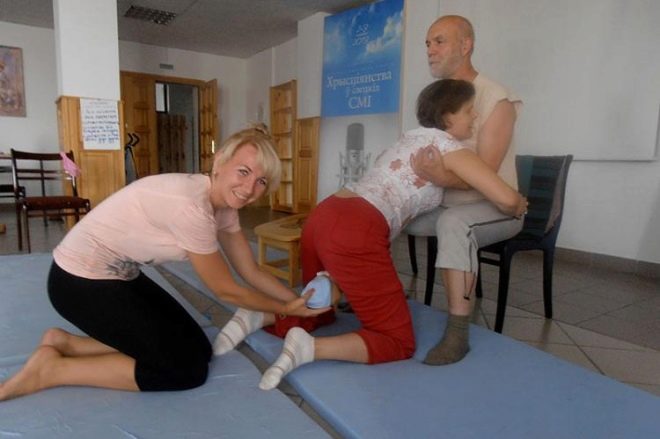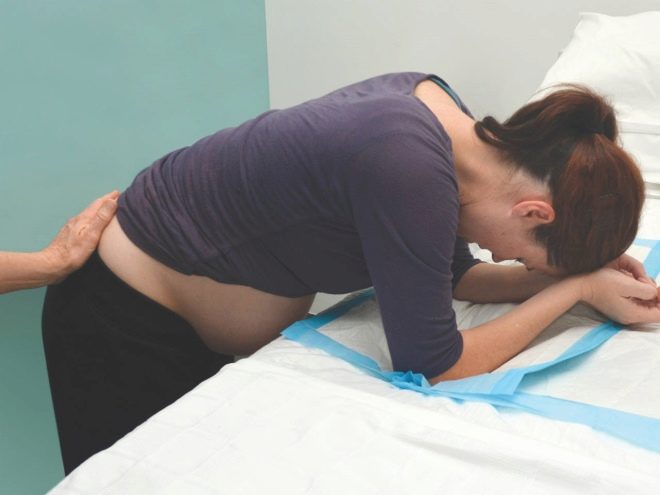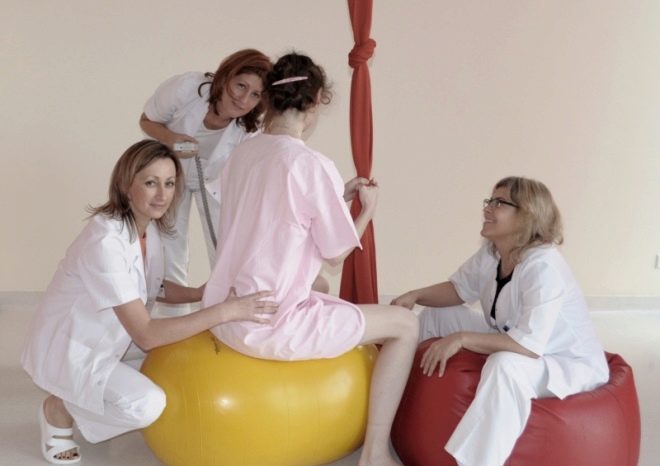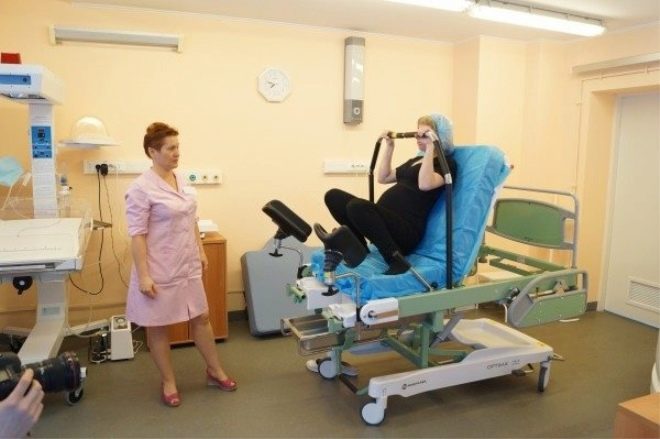How is the vertical birth? Advantages and disadvantages
Many methods of natural anesthesia of childbirth refer to the preference of vertical births over horizontal ones. To give birth in an upright position recommend the method of Lamaz, the majority of modern doctors in Europe, the United States and many other countries of the world. In Russia, vertical childbirth has not yet become widespread, but “the ice has broken”, and more and more women are going to the maternity hospital with a preliminary agreement on such genera.
That this and how such a birth of a baby passes, we will tell in this article.
What it is?
As the name implies, vertical childbirth is different from the traditional position of the woman in the body in space. Childbirth occurs when a woman is in an upright position - standing, squatting, etc. In this case, the woman chooses the body position based on her own feelings and comfort.
There is nothing new, in fact, in this method of delivery. So gives birth to the majority of mammals on the planet. Among people such genera are widespread in Asia, Africa, and South America.
In Europe, the fashion to give birth in a natural, natural position came from France. It was there that they officially began to carry out the first vertical labor. Following the French tried the technique of a resident of Holland and Germany.
Few people know, but in Russia professional midwives also forced the woman in labor to rise and walk in the bath. Therefore, this way of giving birth has very old and very deep traditions. It is believed that the vertical position of the most natural and physiological.
In Soviet maternity homes, women were forced to lie down during labor and during attempts at obstetric beds. Now all women in labor are encouraged to move during labor. But not all physicians agree on the vertical position in the attempts.
It should be noted that For vertical deliveries, the presence of a partner is mandatory. Either it must be the husband of the woman in labor, or another relative to whom she entirely trusts, or the health worker with whom an agreement on vertical birth has been previously reached. In this case, the partner is not an observer. He is an active participant in the process on which a woman can lean on, on which she can hang, if she is so comfortable.
Keeping birth in an upright position requires separate skills from an obstetrician. If an expert is trained in this, he must necessarily have an appropriate license. It is necessary to take an interest in her presence when choosing a maternity hospital, if a woman has a vertical birth in priority.
Advantages and disadvantages
Deliveries in the supine position are more painful and are associated with increased risks of childbirth. This is due to gravity - the heavy uterus with the fetus puts pressure on the spine, squeezes the aorta, the inferior vena cava. This increases the likelihood of hypoxia in the fetus, leads to a violation of the level of blood pressure in the mother. Vertical delivery, again according to gravity, does not cause infringement of blood vessels. Control using CTG during labor confirms that the state of the fetus in vertical childbirth is always more prosperous than with classical birth on the back.
Pain in childbirth in a vertical position is reduced by reducing the gravitational load on the back. Therefore, the need for medical anesthesia is reduced. Even relatively mild epidural anesthesia affects the fetus.Its use in vertical birth is not found. Also, it is rarely necessary to use stimulants - contractions in an upright position rarely uncoordinated or weakened.
The period of labor in classical childbirth, according to experts, lasts about three hours longer than vertical. Cervical dilatation is proceeding at a faster pace, again due to the gravitational fields and the pressure of the baby’s head.
Attempts in an upright position are less painful, not only the labor forces, but also the force of gravity are pushed out in the plow stage of the birth process of the baby. Babies get injuries less often, because the advancement becomes softer and more delicate, because the woman feels the muscles of the perineum and pelvic floor well. The period of the attempt itself is increased by about half an hour, but a slower exit of the baby ensures a low probability of injury.
The third period of childbirth in vertically giving birth is usually faster - the placenta moves away more easily under the action of gravity. This reduces blood loss of approximately 200 ml. Recovery from such childbirth proceeds faster, not only in the puerperal, but also in the baby. Adaptive abilities of such children are evaluated significantly higher than in children who appeared during classical labor or as a result of a cesarean section.
If a woman has myopia, there was a history of retinal detachment, there are heart ailments, then there was only one way out - a cesarean section, because it is not recommended for such women to push. Today, with such indications, vertical births are quite successfully carried out without harm to the health of the mother and baby.
Despite all the above advantages, this delivery procedure also has disadvantages:
- it is more difficult for the obstetrician to monitor the condition of the fetus, to make CTG in attempts, to record the baby’s heartbeat;
- epidural anesthesia cannot be applied, because the lower part of the body will partially lose sensitivity, the woman will not be able to control her feelings;
- if the perineum has anatomical defects, the likelihood of ruptures increases, while in a vertical position obstetricians can do almost nothing to prevent injury to the mother;
- in the upright position increases the likelihood of rapid delivery, which can lead to injury to the fetus;
- under any unforeseen circumstances, it is more difficult for the obstetrician to give help to a woman who is in an upright position.
Who is contraindicated?
Deliveries in the upright position of the body have a number of contraindications, and therefore may not be allowed to all pregnant women. So, you can not give birth upright ladies in the following situations:
- pronounced pathology of pregnancy;
- childbirth began prematurely;
- the baby is in pelvic, transverse, or other pathological presentation;
- a woman has a clinically narrow pelvis;
- the child has a large head;
- the woman has chronic diseases of the internal organs.
Even if vertical labor is allowed, the decision can be changed at any time and the woman will be transferred to the classic position if complications arise in the process of labor, if doctors need to use forceps or other equipment.
How to prepare?
Preparing for childbirth in an upright position with special diligence. Be sure to learn to relax the muscles and breathe properly during fights and strokes. Courses will have to go with a partner. There will be shown exercises for two on acceptable postures and support, which is desirable to rehearse at home. During vertical childbirth a woman can use a fitball.
Preparation will require the collection of necessary documents not only for the parturient, but also for her partner - without a list of test results and conclusions, the doctors of the partner will simply not be allowed into the hospital. You also need to carefully review the "assortment" of maternity hospitals and perinatal centers, find a doctor who is a supporter of vertical birth and sign the exchange card with the head or chief doctor of the chosen obstetric institution.
Posture and chair
Separate recommended poses for vertical delivery does not exist. Their charm is precisely that the woman in labor can choose any position of the body, if only she was comfortable. Most often women squat, stand on all fours, take a knee-elbow posture, hang on the neck of a partner. Posture should be studied in advance and rehearse at home, but you should not choose your preferred ones in advance - childbirth will definitely make its own adjustments.
In the period of attempts, the squatting pose is considered the most effective. During labor, a woman can change her postures arbitrarily, as she likes. But almost all of them will require the physical support of the partner, not only during the bouts, but also during the painful period.
There is a special chair for vertical delivery. On it, a woman can take any position, but only not to lie down. Taz is constantly on weight. Such equipment is quite simple, but so far there is not in every maternity hospital.
Minus chairs - in its height. It is rather low, and for a doctor it is not too comfortable - you have to sit in a crooked state or kneel. Such variability of the necessary behavior makes vertical delivery not the most favorite among obstetrician-gynecologists.
Useful tips
Today, with the development of paid medicine, there are many who want to make money on the desire of a couple to give birth the way they want. Not all hospitals agree to accept vertical childbirth, this is still a fact. But there are more and more private clinics that offer such services for a lot of money. At the same time, often the “specialists” of such clinics not only do not have a license for the right to take vertical childbirth, but sometimes do not have medical education.
Often with such charlatans can be encountered on the courses of preparation for vertical childbirth. In a number of regions of Russia, there were conflicts in which the organizers and teachers of vertical birth schools did not have medical education and harm their clients, who paid considerable money for their classes. When choosing courses and maternity hospital, the woman and her partner should be attentive. It is about the health of two - mother and baby. Be sure to make sure you have a license and ask about the qualifications of the doctor.
Women reviews
Reviews of vertical births are mostly positive. Especially valuable is the opinion of women who first gave birth in a classic position. They note that it is easier to give birth vertically, pain is less pronounced.
The first period of childbirth, according to reviews, can be quite tedious for a woman in labor: walking, standing and hanging with contractions quickly get bored. But the advantages of the period are assessed by all without exception. Almost no reviews about injuries from mothers in such childbirth. There are no reviews of birth injuries in the infant. Often women complain that the doctors, even agreeing to vertical childbirth, did not give the woman in full freedom of choice to pose, imposed a semi-sitting position in which it was easier for them to work without taking into account the opinion of the woman in labor.
Can I give birth vertically for free? You can, reviews confirm this. True, for this, several conditions must coincide: the maternity hospital must support vertical delivery, there must be such doctors, a separate generic one, because the presence of a partner is assumed. In this case, the policy is sufficient. In other cases, you will have to enter into a contract for paid medical services and separately register all the designated items in the contract.
On the pros and cons of vertical delivery, see the following video.
























